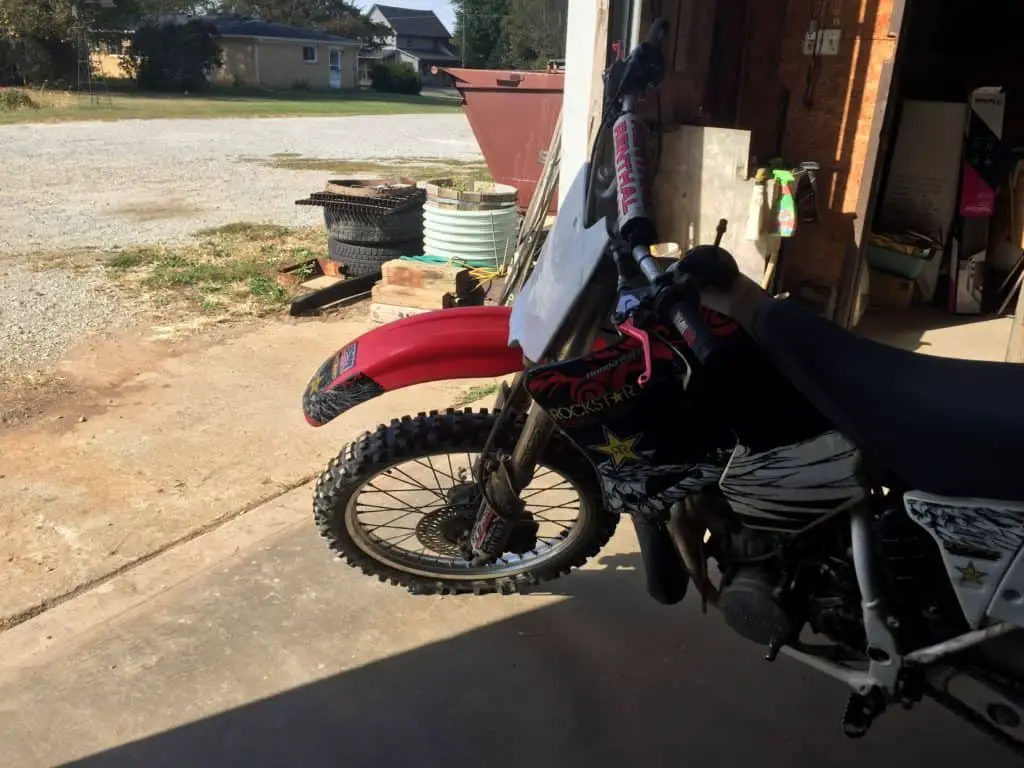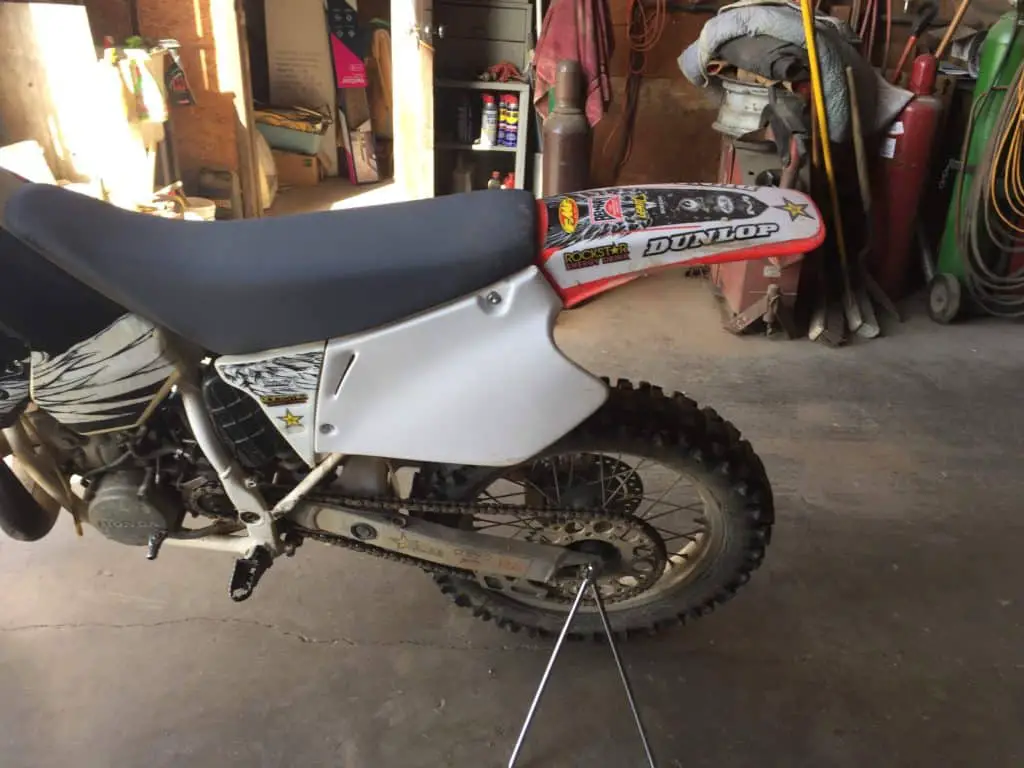
Recently, my spouse was telling me about a couple riding an ATV on the rode, I could not help but wonder if you could ride a dirt bike along the side of the road.
Can you ride a dirt bike on the side of the road? No, most states and providence have rules about what motorcycles we can ride on the road or on the sides of the road. Dirt bikes with rare exceptions do not meet these regulations because they lack turn signals, license plates, and DOT approved tires. They will consider the shoulder of the road part of the road.
Even with a tough answer there is more to examine that may eventually allow you to move from riding your dirt bike from the side of the road to becoming a full-blown street legal motorcycle. First you need to know a few basics before converting our dirt bike.
Can I ever use my dirt bike as transportation?
Using a dirt bike as everyday transportation would get you into trouble at some point if you are traveling around a city or suburban area. The police will catch up with you and likely impound the bike. Even if you get away with it for a while, someone will eventually report you which again means you’ll get caught.
You also need to consider the safety items we touched on about a traditional dirt bike. They lack proper safety items like street tires. To illustrate my point, consider the BMX bike you probably had as a kid. Did it have knobby tires on it? How was it riding on the street during or after it rained?
It was great for skidding and sliding, but sucked if you needed to ride fast. They designed the tires for dirt not for pavement or asphalt use. The same issue arises with the dirt bike tires on the street or side of the road (unless it is a grass or dirt shoulder.)
The Two Times It Makes Sense To Use Dirt Bike As Transportation
I do not know if you can call it transportation in the sense of traveling from one end of town to the other. But you can if you used to think about it as moving from one place to another.
This one time will be on large private plots of land like maybe a ranch or large farm. Here using a dirt bike makes sense. You will not be on asphalt roads or encountering much traffic.
The second and rare exception are rural county roads. While finishing the research for an unrelated topic, I found there are in fact a few counties in Indiana that allow someone to ride dirt bikes on the road or side of the road. In most cases there needs to be little traffic or the dirt bike needs to be used for agricultural use.
If you are Indiana residents here is more information from the state government.
What do they consider the side of the road and the road for a dirt bike rider?
The solid lines on the side of the road show the official end of normal traffic lanes and signal the edge of the roadway. Beyond you notice the white solid line on the right telling you where the shoulder beings.
Highway
One easily finds the shoulder section of the road on the highway. Not only do you see the white line, but you may notice reflectors and run over the rumble strips shaking your bike or car while hearing a loud buzzing sound.

Riding on the should of a highway will not be practical for a few reasons:
- Riding your dirt bike on the highway blows your all over the place, even riding on the side by the semis barrelling down the road.
- You’ll have a hard time getting access to the highway, unless you enter at the same place cars and street bikes do. Even then you’re running a large risk, because police often sit on the entrance ramps. There are fences along the highway preventing people from accessing the road.
- Common sense should tell you to avoid riding on the side at night. Fast vehicles, and no lights on your dirt bike make a bad combination.
Country Roads
The actual shoulder on a country road looks very different. The white line noted above on the highway will be right at the side of the pavement leaving little to no room for the traditional shoulder.
You may not even see any lines on a country road. At the edge of the pavement is grass, a ditch, or ruts from where vehicles drop the two right hand tires off the side of the road.

When you ride on the side here, you are trespassing on someone’s property. The obstacles listed above almost make it impossible to ride on the side of the road anyway (except for grass.)
Urban Streets
Everyone has seen a movie with the motorcycle jumping the curb or dipping down into the waterways for the getaway scene. While these seem cool, they are dangerous to ride on a dirt bike.
Also, you will find many fences close to the side of the road in the city. Clip one of those with your handlebars and be ready to take a fall.
Aside from the impractically and obstacles we have gone over with the different roadways, you may be still riding on the government property. The government also has a public right of way on each side of the road. The width depends on the kind of road, regulating government body, and traffic.
If you cannot ride on the side of the road, can you make a dirt bike street legal? Yes, but there are a few things you need to know that make motorcycles street legal.
What makes a motorcycle street legal?
First you need to CLEARLY UNDERSTAND making your dirt bike street legal will be different for each state or country. As a rider you need to complete the research to know the law and how it applies to your situation. The information given here is for general discussion purposes only.
Any ways, there are six things you need at a minimum to make a street legal dirt bike.
- You will need satisfy many of the basic requirements already available on the dirt bike. It sounds silly but these include steering, brakes, tires (see point 5), wheel assemblies, exhaust system, and a VIN. These are already on your dirt bike and seem silly to list. We both know someone tried getting through without one or some of these items.
- You will need a place to mount your license plate so other motorists can see it and to identify your bike.
- You will also need a headlamp. This helps on coming traffic see you and light the road for you at night.
- Put a tail light onto your dirt bike. People will need to see the back of your bike while traveling during the day and night. While not all states require it, make sure the taillight also has a brake light function. I have seen a few bad wrecks from motorists who did not see the brake light on a motorcycle.
- Your tires need to be DOT approved. To my surprise, it shocks many people when they hear different tires will need to be placed on the bike. They do not design dirt bike tires for the street. There are street tires designed for on and off-road use. Most of these will be on adventure bikes. Google adventure motorcycle tires and you’ll head in the right direction.
- Riders need to see what is going on behind them. Be ready to put a mirror on your dirt bike.
Other note worthy items
Many government bodies also require turn signals to which I agree. Other motorist need informed of your intentions when turning or changing lanes.
Places like Indiana require odometers to give the rider speed and mileage stats. More complicated odometers give engine rpm and engine temperature. On a dirt bike conversion, you will only add these if you want the extra work.
Know of decibel levels. This will influence the exhaust on your motorcycle. If you’re too loud, you get a ticket.
Again, complete your research about how to make the dirt bike street legal. Do not be surprised if your government will not allow you to convert your dirt bike either.
What is a street legal dirt bike called?
Once a dirt bike has been converted to a street legal machine, the motorcycling community refers them as dual sport bikes. However, no matter how a dirt bike gets converted, it will still lack some comforts of a motorcycle designed for more street riding.
The major motorcycle manufacturers have recognized the need for riders who want to ride both on and off the street. They created true dual sport machines. These motorcycles come street legal from the factory with a heavy emphasis on dirt riding.
Buying one of these machines will probably save you a lot of time researching laws and on the conversion of the dirt bike. Your pocket book will thank you. These machines are not too different in price versus a dirt bike. Plus, they are more reliable and do not require the frequent maintenance of a dirt bike.
There are a few downsides:
- They are heavier than a dirt bike. The additional weight will not always be bad when riding on wet pavement or riding on windy days.
- For the two stroke fans, few on-road dirt bikes get manufactured today. In fact, I don‘t know of any. You will miss the distinct sound of the two stroke.
- Some of them are not attractive. Beauty is in the beholder’s eye though.
My best suggestion: Instead of worrying about riding on the side of the road, go by a true dual sport motorcycle and ride on and off-road.
Related Questions:
Can you ride a dirt bike on the sidewalk? While I am not a lawyer, the answer will probably be no. Sidewalks are meant for pedestrian and the roads are meant for vehicles. There are rules for what needs to be on the street. Many states have mopeds and bicycles ride on the road. If your dirt bike is street legal and over 50 ccs, consider it a motorcycle and not a moped which has a different set of rules.
Do you need a license to drive a dirt bike on the street? Yes, if your dirt bike is street legal, you will need a license to ride it on the street. Your first major challenge will convert your dirt bike to make it street legal. All the laws and rules that apply to a street motorcycle will also apply to your converted street dirt bike.
